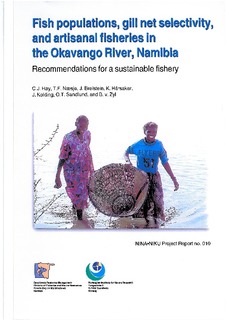| dc.description.abstract | Hay, C.J., Næsje, T.F., Breistein, J., Hårsaker, K., Kolding, J., Sandlund, O.T. & van Zyl, B. 2000. Fish populations, gill net selectivity, and artisanal fisheries in the Okavango River, Namibia. Recommendations for a sustainable fishery. — NINA-NIKU Project Report 010: 1-105.
Objective:
The objective of this report is to produce guidelines for a sustainable management of the fisheries in the
Okavango River, Namibia, based on fish survey data for the years 1992-1999. Data were also coHected regarding the subsistence fishery in the river. The rationale for the report is the 1995 White Paper "Responsible Management of the Inland Fisheries of Namibia" and the draft bill on inland fisheries. These have the objectives of ensuring a sustainable and optimal utilisation of the freshwater resources, and to favour utilisation of fish resources by subsistence households over commercialisation. The stated policy takes into consideration the large differences among water systems in Namibia and proposes adoption of sepa rate management regimes for the various river systems.
Material and study area:
Fish were collected in seven main areas (Matava, Musese, Bunya, Rundu, Cuito, Mbambi, and Kwetze) with survey gill nets (22-150 mm stretched mesh) and 16 other sampling methods, such as seine nets, mosquito nets, cast nets, angling, electrofishing apparatus, rotenone and different traditional gears.
These are later collectively called "other gears". The stations were selected to include all main habitats present in the Okavango River. The gill nets were mainly used in relatively deep water, whereas the other gears were mainly used in shallow and vegetated habitats. All seven localities were sampled at least once a year between 1992 and 1999. A total of 47438 fishes were sampled, 13559 in gill nets, and 33879 in other gears.
The Okavango River originates in the central highlands of Angola at approx. 1700 m a.s.l. and enters Namibia at Katwitwi. The river forms the border between Namibia and Angola before turning south towards Botswana. Along the Namibian section of the river, there are large floodplains with sandy substrates and rocky outcrops, and abundant aquatic vegetation. After a distance of 460 km within Namibia, the river enters Botswana where it evaporates in the swamps of the Okavango Delta.
The annual flood in the Namibian portion of the Okavango starts during December reaches its peak in
March-April and recedes during May. The annual discharge of the Ol avango at Rundu is between 5,000 and 6,000 million m3. Below the confluence with the Cuito River, the annual discharge nearly doubles to over 10,000 million m3.
More than 136,000 people live in the Okavango region. An estimated 90 % of the population live within 10 km of the river, and many of the economic and social activities in the region are connected to the river. More than 50 % of the human population along the river do fish, both with traditional gears such as baskets, funnel traps and fences constructed of plant material, and with some modern gears such as gill nets, seines, hook and line, and mosquito-nets. For more than 90 % of the households fish is a source of subsistence, and sales of fish provide some income for approximately 45 % of the households. The highest population density is at Rundu, whereas no people live at Kwetze, which is within the Mahongo Game Park. It is assumed that the fishing pressure is correlated to the riparian population density. | nb_NO |
